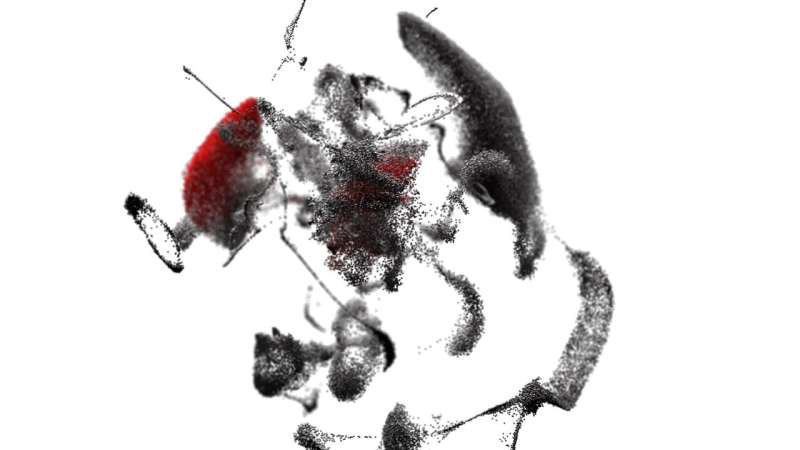This article has been reviewed according to Science X's editorial process and policies. Editors have highlighted the following attributes while ensuring the content's credibility:
fact-checked
peer-reviewed publication
trusted source
proofread
Open-source project maps the biology of spinal cord injury in unprecedented detail

Scientists at EPFL have achieved a significant research milestone in the field of spinal cord injuries—mapping out the cellular and molecular dynamics of paralysis in unprecedented detail with their open-source project titled "Tabulae Paralytica."
Grégoire Courtine and his team have integrated cutting-edge cell and molecular mapping technologies with artificial intelligence to chart the complex molecular processes that unfold in each cell after spinal cord injuries (SCI). Published in Nature, this seminal work not only identifies a specific set of neurons and genes that plays a key role for recovery but also proposes a successful gene therapy derived from its discoveries.
Understanding why spinal cord injuries are nearly impossible to heal sheds light on the significance of this breakthrough. The human spinal cord is one of the most complex biological systems known to science—it is a mechanical, chemical, and electrical arrangement of different types of cells working in harmony to produce and regulate a multitude of neurological functions, including a natural, elegant gait. This cellular complexity amplifies the challenges of effectively treating paralysis caused by injury to the spinal cord.
Until now, traditional imaging and mapping methods have offered a generalized view of the cellular mechanisms of SCI. But this lack of specificity blurs the distinct roles and reactions of individual cell types and has hindered the development of targeted treatments, as therapies could not be finely tuned to address specific cellular dynamics.
"In this study, we aimed for nothing less than a revolution in the biological understanding of spinal cord injury," says Courtine. "By offering an exceptionally detailed view of the cellular and molecular dynamics of spinal cord injury in mice across space and time, the four cell atlases comprising the Tabulae Paralytica close a historic knowledge gap, paving the way for targeted treatments and enhanced recovery."
The first treatment to come from this new understanding of the intricate cellular dynamics of paralysis is a targeted gene therapy. Developed in collaboration with fellow EPFL Neuro X professor Bernard Schneider, the therapy leverages a crucial finding: The researchers found that a specific type of support cell called an astrocyte loses its ability to respond to injury in aged animals.
"For much of the last hundred years, it was believed that astrocytes were detrimental to neural repair. Our data further supports overturning this notion and suggests an essential protective role for these cells that can be exploited to repair spinal cord injuries," says EPFL's Mark Anderson, senior author of the study.
Another key result of the study is the identification of a specific subset of neurons, known as Vsx2 neurons, that are inherently equipped to promote recovery.
"Our previous studies have pointed in their direction, but with this new, fine-tuned understanding, we can now say for certain that Vsx2 neurons are largely responsible for neural circuit reorganization, meaning that they are by far the most interesting population of neurons for repairing spinal cord injury," says Jordan Squair, another senior author of the study from EPFL.
To create the first-ever comprehensive cellular map of spinal cord injuries in rodent models, the researchers employed two innovative technologies. The first, single cell sequencing, examines the genetic makeup of each cell. While it has been employed for over a decade, recent advances allowed the scientists to scale up the process like never before, generating detailed accounts of millions of spinal cord cells.
Secondly, spatial transcriptomics—a cutting-edge technology that shows us where these cellular activities occur—expanded the map across the entire spinal cord, preserving the spatial context and relationships between different cell types.
The new data is so vast that new machine learning techniques had to be developed specifically to harness its intricacy. This computational approach leverages artificial intelligence to not only chart the immediate genetic responses of individual cells but also situate these responses within the physical and temporal landscape of the spinal cord.
"We now have a detailed map that not only shows us which cells are involved but also how they interact and change over the course of the injury and recovery process," explains Squair. "This comprehensive understanding is crucial for developing treatments that are precisely tailored to specific cells and unique requirements for repair of varying injuries, paving the way for more effective and personalized therapies."
The Tabulae Paralytica is a significant milestone in SCI research. It combines scientific insight with technological innovation to open new horizons in the understanding and treatment of SCI. Although this study has been conducted using rodent models, the insights gained are expected to translate into clinical applications, where Courtine and his team have been making significant advances for over a decade.
More information: Grégoire Courtine, Single-cell and spatial atlases of spinal cord injury in the Tabulae Paralytica, Nature (2024). DOI: 10.1038/s41586-024-07504-y. www.nature.com/articles/s41586-024-07504-y




















